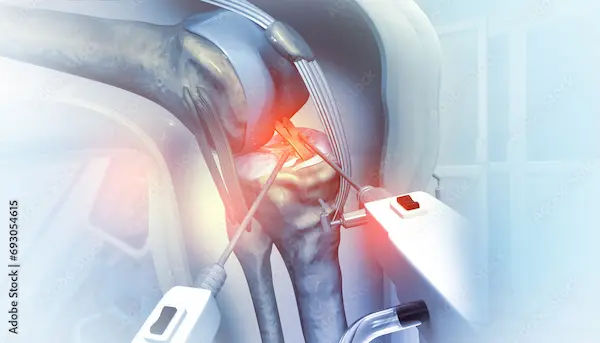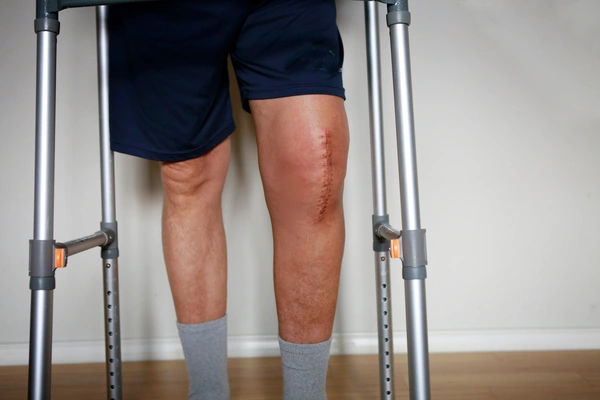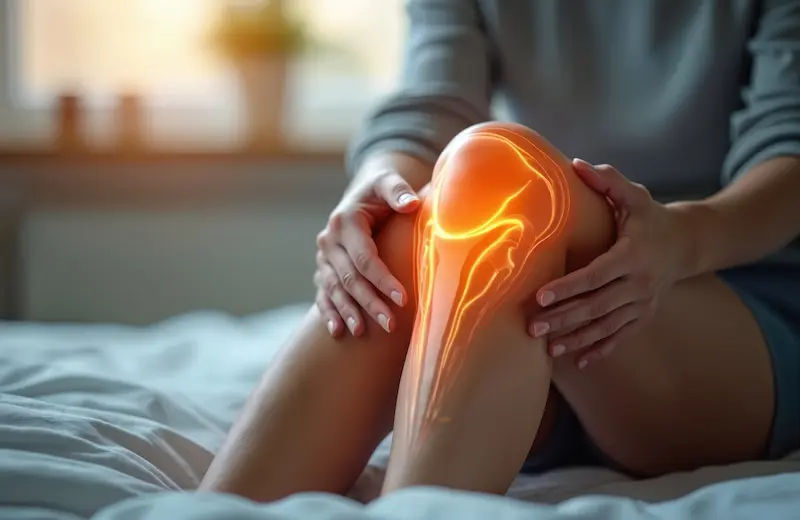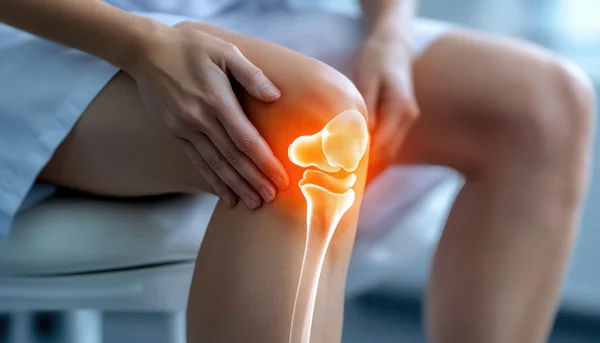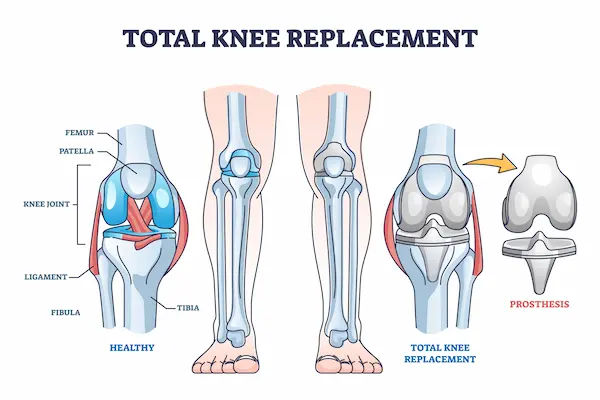Guide to Myths And Facts Total Knee Replacement Tkr
Know about the total knee replacement, ten myths and facts busted and more.

Written by Dr. Dhankecha Mayank Dineshbhai
Reviewed by Dr. Rohinipriyanka Pondugula MBBS
Last updated on 23rd Sep, 2025

Is chronic knee pain turning simple walks into a daunting task? If your doctor has mentioned Total Knee Replacement (TKR), your mind might be swirling with frightening stories and misconceptions. It's one of the most successful orthopaedic procedures globally, yet it's shrouded in outdated myths that prevent many from seeking the relief they deserve. This guide cuts through the noise to separate the frightening fiction from the empowering facts. We'll debunk the top 10 myths about TKR, giving you clear, evidence-based information to help you make an informed decision about your health and mobility. Understanding the reality of modern knee replacement is the first step toward reclaiming your active life without pain.
MYTH1: You Should Wait as Long as Possible Before Considering Surgery
Many people believe that knee replacement is a "last resort" procedure to be delayed indefinitely. They endure years of pain, reduced activity, and a diminished quality of life based on this common misconception.
The Fact: Delaying Can Cause More Harm Than Good
- The "wait until you can't stand it" approach is outdated and potentially harmful. Prolonged severe pain and disability can lead to:
- Muscle Atrophy: Weakness in the quadriceps and hamstrings, making post-surgery rehabilitation more challenging.
- Joint Deformity: Advanced arthritis can cause knees to bow in or out, complicating the surgery.
- Overall Health Decline: A sedentary lifestyle due to knee pain can contribute to weight gain, cardiovascular issues, and loss of bone density.
Consult an Orthopaedic for Personalised Advice
The Right Time for TKR: It’s About Quality of Life, Not Just Age
- The decision shouldn't be based on a calendar age but on your biological age and lifestyle. The right time is when:
- Your knee pain is severe, constant, and not relieved by conservative treatments (medication, physiotherapy, injections).
- Your mobility is significantly limited, affecting daily activities like shopping, climbing stairs, or walking.
- The pain causes stiffness and swelling that doesn't improve with rest.
- Your quality of life is noticeably degraded.
If your condition is progressively worsening despite trying other methods, consulting an orthopaedic surgeon is a
proactive step, not a last resort.
Myth 2: Total Knee Replacement Surgery is Excruciatingly Painful
This is perhaps the most pervasive myth. Visions of a painful, gruelling recovery scare countless people away from the procedure.
The Fact: Modern Pain Management Has Revolutionised Recovery
While TKR is a major surgery and some discomfort is expected, the idea of "excruciating" pain is outdated. Today's
pain management strategies are highly effective and multifaceted, focusing on preemptive and continuous relief.
A Multi-Modal Approach to Pain Control
Surgeons now use a combination of techniques to minimise pain, which also accelerates recovery:
- Nerve Blocks: anaesthetic is injected around the nerves supplying the knee, numbing the area for 12-24 hours post-op.
- Spinal/Epidural Anaesthesia: Often used instead of general anaesthesia, reducing side effects.
- Long-Acting Local Anaesthetics: Injected into the joint during surgery to provide extended pain relief.
- Multi-Modal Drug Therapy: Using a combination of non-opioid pain relievers (e.g., NSAIDs, Acetaminophen) and smaller, carefully managed doses of opioids to maximise pain control while minimising side effects and addiction risk.
Patient testimonials consistently reveal that the pain after a well-managed TKR is far less than the chronic, debilitating pain they lived with for years.
Myth 3: You'll Be Bedridden and Out of Action For Months
The image of a patient confined to a bed for weeks on end is a relic of the past.
The Fact: Rapid Recovery Protocols Get You Moving Quickly
- Modern TKR surgery, especially with minimally invasive techniques, emphasises getting patients up and moving almost immediately—often within hours of surgery. This is a core component of Enhanced Recovery After Surgery (ERAS) protocols.
- Movement prevents dangerous blood clots.
- It reduces stiffness and promotes circulation for healing.
- It builds confidence and accelerates the rehab process.
A Typical Recovery Timeline: What to Really Expect
- Day of Surgery: You'll be encouraged to sit on the edge of the bed and may take a few steps with a walker.
- 1-3 Days Post-Op: You'll be walking with assistance, navigating stairs, and beginning physical therapy exercises.
- 1-6 Weeks: You'll transition from a walker to a cane and gradually increase strength and mobility with home exercises or outpatient physiotherapy. Many return to sedentary work within 4-6 weeks.
- 3-6 Months: Most daily activities are resumed. Strength and endurance continue to improve.
Myth 4: You Can't Kneel, Run, or Enjoy an Active Lifestyle After TKR
Many fear that a knee replacement means the end of an active life.
The Fact: Most Patients Return to Low-Impact Activities and More
The primary goal of TKR is to restore your active lifestyle. The vast majority of patients return to:
- Walking without a limp
- Swimming, cycling, and golfing
- Dancing, hiking, and gardening
- Low-impact sports like doubles tennis
Understanding the Realistic Boundaries of Your New Knee
While TKR is fantastic for eliminating pain and restoring function, high-impact activities like running or jumping are
generally discouraged. These activities can accelerate wear on the polyethene plastic spacer in the implant. However, some patients do report being able to kneel comfortably, though sensation may feel different. The key is setting realistic expectations with your surgeon about your desired post-surgery activity level.
Myth 5: The Artificial Knee Will Feel "Mechanical" or "Weird"
People imagine a loud, clunking hinge that they will always be aware of.
The Fact: Most Patients Forget They Even Have an Implant
Modern implant designs are engineered to replicate the natural kinematics of the knee joint closely. The materials
(typically cobalt-chrome and polyethene) are smooth and quiet. After the initial healing period, the knee feels stable and natural. The overwhelming sensation patients report is the absence of pain, not the presence of a mechanical device. The grating, bone-on-bone feeling of severe arthritis is replaced by a smooth, pain-free glide.
Myth 6: Knee Implants Only Last 10 Years
This myth was more accurate decades ago, but it hasn't kept pace with technology.
The Fact: Modern Implants Can Last 20-30 Years or More
Thanks to advancements in materials, surgical technique, and implant design, today's knee replacements are incredibly durable. Studies show that over 90% of modern knee implants are still functioning well after 15 years, and more than 80% last 25 years or longer. For most patients, especially those over 60, this means the replacement can realistically last for the rest of their lives.
Myth 7: TKR is Only for the Elderly
While common in older adults, severe arthritis does not discriminate by age.
The Fact: Younger Patients Are Common Candidates
An increasing number of younger patients (in their 50s and even 40s) are undergoing TKR. The driving factor is not age but the severity of joint damage from osteoarthritis, rheumatoid arthritis, or post-traumatic arthritis from an injury. With the improved longevity of implants, surgeons are more confident than ever in offering this life-changing procedure to younger, active individuals to restore their function and prevent years of unnecessary suffering.
Physical Therapy is Optional After Surgery
Some believe the surgery alone is the fix and that rehab is just an extra, painful step.
The Fact: PT is Non-Negotiable for a Successful Outcome
Physical therapy is the cornerstone of a successful recovery. The surgery replaces the joint, but physiotherapy restores the function. It is essential for:
- Regaining range of motion and flexibility.
- Rebuilding strength in the muscles that support the new joint.
- Relearning proper walking patterns (your gait).
- Ensuring you achieve the best possible outcome from your surgery.
Skipping PT can result in a stiff, weak knee and poor functional results. Your commitment to rehab is as critical as the surgeon's skill.
Conclusion
Navigating the decision to have a Total Knee Replacement can feel overwhelming, but it shouldn't be guided by fear and misinformation. As we've uncovered, the realities of modern TKR are far more positive than the myths that surround it. It is a proven, highly successful procedure designed not to limit your life, but to liberate you from pain and restore your mobility. The key is to have an open, honest conversation with a qualified orthopaedic surgeon who can evaluate your individual situation. They can provide personalised insights into the benefits of robotic knee surgery, precise recovery expectations, and how this procedure can specifically enhance your quality of life. If knee pain is holding you back from living fully, seek expert advice. Taking that step could be the beginning of your journey back to a pain-free, active future. If your knee pain is impacting your daily life, consider consulting an orthopaedic specialist online with Apollo24|7 to discuss your options.
Consult an Orthopaedic for Personalised Advice
Consult an Orthopaedic for Personalised Advice
Dr. Anil Sharma
Orthopaedician
42 Years • MBBS, MS Orthopedics
New Delhi
AAKASH MEDSQUARE, New Delhi

Dr. Anil Pradeep Jadhav
Orthopaedician
23 Years • MBBS MS (Ortho)
Nashik
Apollo Hospitals Nashik, Nashik
(25+ Patients)
Dr. Vamsi Krishna Reddy
Orthopaedician
6 Years • MBBS, M.S.Orthopaedics
Guntur
Sri Krishna Orthopedic And Dental Hospital, Guntur

Dr. Pradeep Lucas
Orthopaedician
7 Years • MBBS, Diploma in Orthopaedics, Fellowship in DFSI
Bengaluru
Revival Multispeciality Clinic, Bengaluru

Dr. Manoj Dinkar
Orthopaedician
15 Years • MBBS, Dip (Orthopaedics)
New Delhi
THE DOCTORS NESST, New Delhi
Consult an Orthopaedic for Personalised Advice
Dr. Anil Sharma
Orthopaedician
42 Years • MBBS, MS Orthopedics
New Delhi
AAKASH MEDSQUARE, New Delhi

Dr. Anil Pradeep Jadhav
Orthopaedician
23 Years • MBBS MS (Ortho)
Nashik
Apollo Hospitals Nashik, Nashik
(25+ Patients)
Dr. Vamsi Krishna Reddy
Orthopaedician
6 Years • MBBS, M.S.Orthopaedics
Guntur
Sri Krishna Orthopedic And Dental Hospital, Guntur

Dr. Pradeep Lucas
Orthopaedician
7 Years • MBBS, Diploma in Orthopaedics, Fellowship in DFSI
Bengaluru
Revival Multispeciality Clinic, Bengaluru

Dr. Manoj Dinkar
Orthopaedician
15 Years • MBBS, Dip (Orthopaedics)
New Delhi
THE DOCTORS NESST, New Delhi
More articles from Total Knee Replacement
Frequently Asked Questions
1. Can weather changes affect my new knee replacement?
Some patients report feeling sensitivity or mild achiness in their new joint with barometric pressure changes (like before a storm). This is usually minor and temporary, and far less severe than the pre-surgery arthritis pain.
2. Will I set off metal detectors at airports after a knee replacement?
Most modern knee implants are made of metals like cobalt-chrome and titanium, which may be detected in sensitive airport scanners. It's advisable to inform security personnel that you have a knee implant. You can also ask your surgeon for an implant identification card.
3. How soon can I drive after my surgery?
This depends on which knee was operated on (right is typically longer than left) and whether you drive an automatic or manual transmission. Generally, most patients can resume driving once they are off strong pain medication and can comfortably and safely control the vehicle, often between 4-8 weeks.
4. Is robotic knee replacement better than traditional surgery?
Robotic-arm-assisted surgery is a tool that enhances a surgeon's precision. It allows for more accurate bone cuts and optimal implant positioning, potentially leading to better alignment, less soft tissue damage, and a more natural-feeling knee. Discuss with your surgeon if you are a candidate for this advanced technique.
5. What are the realistic long-term restrictions after a TKR?
The main long-term advice is to avoid high-impact activities like running and jumping to protect the implant from excessive wear. You should also avoid deep, heavy squats or lifting extreme weights. Most other activities, including kneeling (for some), are encouraged to maintain a healthy, active lifestyle.
